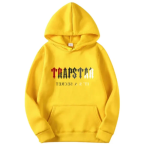Trapstar has carved its place as one of the most influential streetwear brands of the modern era. Founded in London, it has grown from underground beginnings into a global phenomenon, appealing to a generation that values authenticity, edge, and cultural relevance. Unlike brands that chase mainstream appeal, Trapstar has built its identity on rebellion, music, and urban storytelling, making it not just a clothing label but a lifestyle. Its rise illustrates how streetwear can be more than fashion—it can be a form of expression that resonates with social and cultural currents worldwide.
Authenticity as the Core of Trapstar's Appeal
What sets Trapstar apart is its unwavering commitment to authenticity. The brand's designs, collaborations, and messaging are deeply rooted in urban culture, music, and street life, giving it credibility that other brands often struggle to replicate. Each piece tells a story, whether through graphic tees, hoodies, or accessories, and communicates a sense of identity that is both bold and relatable. While many fashion labels rely on celebrity endorsements trapstar or mass marketing, Trapstar's influence comes from its genuine connection to the streets and the community it represents. This authenticity amplifies its cultural impact, making it a brand that not only sells clothing but also shapes the way people experience streetwear.
Innovative Designs That Challenge the Norms
Trapstar consistently pushes the boundaries of design, blending traditional streetwear elements with unexpected details and storytelling. Its hoodies and jackets often feature bold graphics, edgy slogans, and subtle nods to music and street culture that resonate with fans. The brand refuses to conform to the predictable cycles of mainstream fashion, instead carving its own path with designs that feel fresh, innovative, and culturally relevant. This design ethos allows Trapstar to stand apart from competitors, making its clothing not only wearable but also a statement of individuality and cultural awareness.
Cultural Relevance Through Music and Media
A key reason Trapstar outperforms other brands is its deep connection to music, particularly hip-hop and grime. Collaborations with artists, music videos, and media appearances have helped cement its image as more than just fashion—it is a reflection of urban culture itself. Fans don't just wear Trapstar for style; they wear it as a badge of cultural literacy, signaling awareness and alignment with influential music movements. This seamless blending of fashion and cultural participation gives Trapstar a resonance that few other brands can match, making it a dominant voice in global streetwear culture.
Exclusivity and Limited Drops
Trapstar leverages exclusivity in a way that amplifies desire and cultural prestige. Limited edition drops, collaborations, and seasonal collections create a sense of scarcity, turning clothing into a coveted commodity. Unlike mass-market brands, which often dilute value through overproduction, Trapstar maintains its cultural weight by controlling availability and creating anticipation around each release. This strategy not only drives resale markets but also ensures that every piece carries significance, reinforcing the brand's status as an authority in streetwear.
Global Reach and Cross-Cultural Influence
Although rooted in London, Trapstar has transcended geographic boundaries to influence global streetwear communities. Its designs are worn and celebrated in cities across the world, from New York to Tokyo to Paris, proving that authenticity and cultural resonance are universal. The brand's ability to connect with diverse audiences demonstrates that streetwear is not just a local phenomenon but a global cultural language—and Trapstar speaks it fluently. Through collaborations with international artists, influencers, and retailers, the brand continues to expand its footprint while staying true to its identity.
Community and Cultural Belonging
Trapstar's dominance is not just about design or marketing—it's about community. Fans and followers see the brand as a symbol of belonging, a way to align themselves with a subculture that values creativity, authenticity, and urban expression. Wearing Trapstar signals membership in a global community, connecting individuals who share values, aesthetics, and cultural awareness. This sense of belonging amplifies the brand's impact, making it more than clothing—it becomes a social statement and a lifestyle choice that beats other brands that lack such communal resonance.
Celebrity Endorsements and Cultural Amplifiers
While authenticity is at its core, Trapstar has also benefited from strategic celebrity endorsements that amplify its reach. Influential figures in music, film, and sports have been seen wearing the brand, further legitimizing it and expanding its cultural footprint. Unlike traditional celebrity marketing, these endorsements feel organic, rooted in genuine admiration for the brand rather than contractual obligation. This balance between grassroots credibility and high-profile visibility allows Trapstar to maintain its cultural edge while appealing to broader audiences.
Innovation in Digital Engagement
Trapstar understands that streetwear today is not just about physical garments; it's also about digital presence and engagement. The brand has harnessed social media, digital storytelling, and influencer partnerships to amplify its reach, making each drop, collaboration, or campaign a cultural event. By blending offline authenticity with online visibility, Trapstar ensures it stays relevant in a fast-paced, highly connected world. Other brands may rely solely on traditional marketing channels, but Trapstar thrives by engaging communities directly, fostering a sense of participation and anticipation among its fans.
The Future of Trapstar and Streetwear Leadership
Trapstar's dominance is likely to continue as it evolves while staying true to its roots. Its combination of authenticity, innovative design, cultural relevance, community engagement, and strategic collaborations sets a benchmark for all streetwear brands. In a market crowded with competitors, Trapstar's commitment to storytelling, urban credibility, and global connection allows it to beat other brands consistently. As streetwear continues to shape mainstream fashion and influence global culture, Trapstar is well-positioned to remain a leading voice, guiding trends while maintaining the rebellious spirit that made it iconic.
Conclusion
Trapstar is more than a fashion brand; it is a cultural force that beats other brands through authenticity, innovation, and community. Its success lies not just in clothing but in its ability to communicate identity, belonging, and cultural literacy. By connecting fashion with music, urban culture, and global communities, Trapstar has transcended the role of a conventional label. It is a symbol of what streetwear can achieve when it aligns design, narrative, and cultural relevance, making it a brand that continues to set the pace, outshining competitors and redefining what it means to be influential in fashion.






